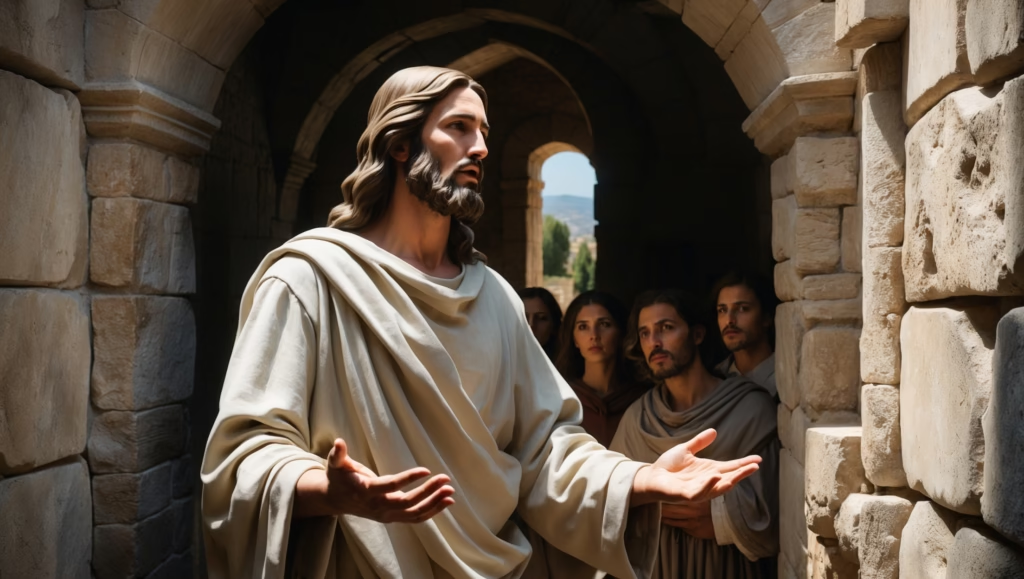How the Messiah Was Heard
The voice of Jesus was more than a vehicle for words—it was a tool for teaching, persuasion, and spiritual authority. While the Gospels emphasize His messages, modern research into acoustics, linguistics, and speech patterns reveals how His voice shaped ministry and reception. By studying the acoustic environments, vocal projection, and speech strategies, we gain insight into how Jesus communicated effectively to crowds, disciples, and opponents in the first-century Judean context.

Audio Forensics: Speaking to Crowds
The Sermon on the Mount (Matthew 5–7) is one of the most iconic examples of Jesus addressing large audiences. Contemporary audio forensics can help us reconstruct how He was likely heard:
- Natural Amphitheater: The Horns of Hattin, overlooking the Sea of Galilee, forms a natural amphitheater. Sound reflections off the hillsides would have amplified a speaker’s voice without modern amplification.
- Crowd Size and Vocal Projection: Estimates suggest thousands gathered to hear the sermon. Jesus would have needed diaphragmatic control and resonance to ensure clarity across distances. Ancient oratory techniques relied on projecting from the chest rather than forcing the throat, minimizing strain while maximizing reach.
- Pauses and Emphasis: The Gospel writer’s punctuation, though modern, reflects natural pauses that likely aided intelligibility, allowing listeners to absorb key points and respond mentally.
This understanding of acoustics illuminates why outdoor preaching was not only strategic but essential for Jesus’ ministry.
Trial Before Pilate: Voice in Confined Spaces
Jesus’ trial before Pilate (John 18–19) presents a contrasting acoustic scenario—an enclosed fortress environment with a smaller audience but heightened stakes:
- Antonia Fortress Acoustics: Stone corridors and small courtyards would have reflected sound differently than open hillsides. Voice control, clarity, and emphasis were critical in ensuring His statements were heard without distortion.
- Aramaic Guttural Emphasis: Jesus’ mother tongue, Aramaic, contains distinct consonantal and guttural sounds that carry projection efficiently. Subtle variations in stress and pitch could command attention, convey authority, or underscore irony in dialogue.
- Strategic Silence: In several trial scenes, Jesus’ deliberate pauses (Matthew 27:14) demonstrate a rhetorical mastery, using silence as a form of control and power in conversation.
The combination of environment, vocal technique, and psychological timing contributed to His effectiveness in both open and confined settings.
Linguistic Insights: The Art of Speech
Jesus’ speech patterns reflect a sophisticated understanding of audience psychology, rhythm, and memory:
- Parable Pacing: Short, vivid stories with dramatic climaxes helped listeners retain teachings. Pauses before key punchlines or lessons created anticipation, reinforcing memory encoding.
- Repetition and Parallelism: Hebrew and Aramaic traditions favored repeated phrasing, making sermons memorable and orally transmittable across generations.
- Silence and Gesture: Nonverbal cues—raising hands, pointing, or walking among listeners—amplified meaning beyond mere words. Voice, gesture, and environment combined to create a multi-sensory teaching experience.
These patterns suggest that Jesus’ effectiveness was as much about how He spoke as what He said.
Modern Recreations: Bringing the Voice to Life
Today, scholars and technologists seek to recreate Jesus’ voice for educational, liturgical, and scientific purposes:
- AI Voice Modeling: Using vocal reconstruction algorithms based on Shroud data, linguistic studies, and historical phonetics, researchers simulate how Galilean accents and Aramaic intonation might have sounded. These models provide immersive experiences of first-century preaching.
- Deaf Ministry and Sign Language: Modern ministries emphasize translating Jesus’ messages into sign language, acknowledging that communication is not only auditory but visual. Insights from speech pattern analysis inform gesture timing, phrasing, and rhythm for clarity in non-verbal communication.
- Acoustic Experiments: Experimental setups in amphitheaters, valleys, and reconstructed synagogues test voice projection, showing that natural architecture could allow a single speaker to address thousands effectively without amplification.
Such projects bridge historical, theological, and scientific perspectives, demonstrating that voice is an integral dimension of ministry.
Theological Implications of Voice
The study of Jesus’ voice goes beyond technical curiosity; it carries theological significance:
- Embodied Ministry: Voice illustrates how the incarnation engaged the physical body to transmit divine truth. Speech was not abstract; it was corporeal and situationally attuned.
- Authority Through Presence: The combination of vocal control, strategic silence, and gestures reinforced the perception of authority, echoing Old Testament prophetic traditions (e.g., Elijah and Moses).
- Inclusive Communication: By mastering different acoustic and social contexts—from hillsides to courts—Jesus demonstrated a ministry attentive to diverse audiences, from multitudes to individuals.
These reflections show that speech and sound are theological vehicles as much as words or miracles.
Modern Applications: Communication, Worship, and Technology
Understanding Jesus’ speech strategies informs contemporary practice in multiple fields:
- Leadership and Education: Studies in emotional intelligence and rhetoric use Gospel interactions as models for conflict resolution, teaching, and persuasive communication.
- Church Acoustics: Architects design sanctuaries to optimize natural projection and clarity, drawing lessons from ancient amphitheaters and the Galilean landscape.
- Digital Faith Tools: VR experiences, AI-driven immersive sermons, and augmented reality Bible apps attempt to replicate the resonance, pacing, and spatial awareness of first-century preaching.
By applying these insights, modern worship and pedagogy reconnect with the embodied, auditory dimension of Jesus’ ministry.
Key Insight: Hearing the Messiah
Examining acoustics, linguistics, and speech patterns reveals that Jesus’ voice was carefully attuned to context, audience, and message. From the natural amphitheaters of Galilee to the echoing halls of Pilate’s fortress, His vocal strategies enabled His teachings to resonate both physically and spiritually.
The voice of Christ exemplifies how ministry integrates body, environment, and communication: projecting authority, conveying compassion, and guiding spiritual formation. Understanding these elements allows contemporary believers and scholars to appreciate the Gospel not merely as text but as a living, audible experience.









